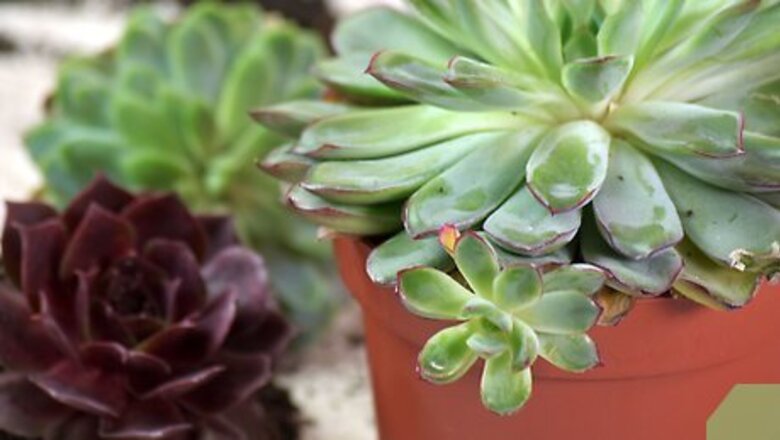
views
Choosing Your Plants and Container
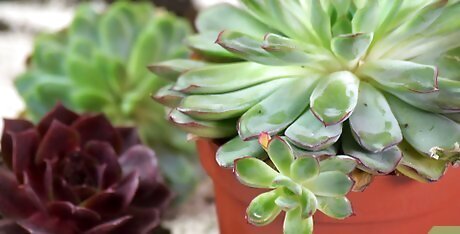
Select plants with similar needs. You can grow just about any low-maintenance plant in a terrarium, but you’ll need to choose plants that will grow well together. Get a selection of plants that grow in similar conditions in the wild, such as woodland, desert, or tropical plants. For instance, if you choose a woodland theme, you might grow moss, foam flowers, and hepatica. Many of these plants do best in cool, shady conditions. Desert plants, such as cacti and other succulents, do best with brighter light and low humidity levels. Tropical plants, like Tahitian bridal veil and Venus fly traps, like warm and humid conditions.
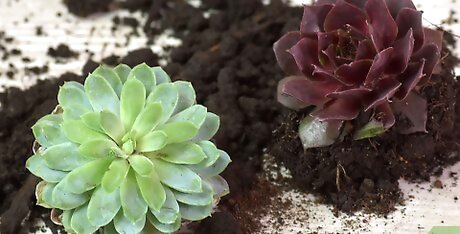
Pick plants that stay small. Plants that grow really wide or tall aren’t the best options for terrarium gardens. Instead, stick to small, low-growing plants, or those that can be easily pruned down to a manageable size. For example, starfish plants are ideal for terrariums since they only grow to be about 6 inches (15 cm) tall when they’re fully mature. Some terrarium plants, like club moss, like to spread horizontally. You may need to trim them back to keep them from taking over the entire terrarium. Others, like the false aralia, need to be pruned to prevent them from getting too tall.
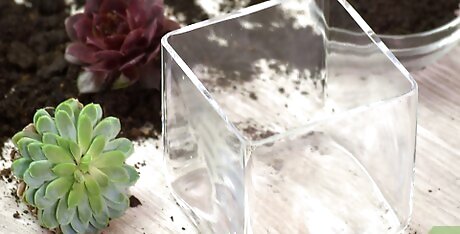
Opt for an open glass container for low-moisture plants. You can use just about any kind of glass container for a terrarium, from a fish tank to an old-fashioned glass bottle. However, if you’re growing plants that like dry conditions, such as succulents, you’ll need a container that doesn’t retain too much moisture. Choose an open container with relatively low sides for these kinds of plants. For example, a fish tank or an old punch bowl could make a great terrarium for some haworthia, hens and chicks, and mini-cacti. Avoid growing succulents or cacti in containers with tall or curved walls, since these retain more humidity and don’t promote good air flow.
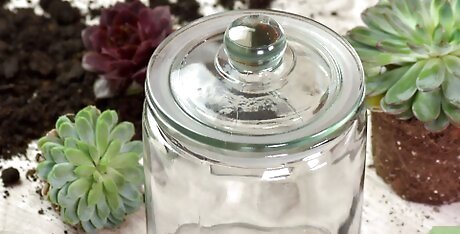
Get a more enclosed glass container if your plants like humidity. Tropical and woodland plants typically enjoy plenty of moisture, so they do best in more closed-off environments. If you have plants that need humidity, try using a container such as a jar, a vase with a broad bottom, or a Wardian case (which looks like a tiny greenhouse). Some plants that do well in more enclosed containers include ferns, begonias, mosses, and ivies. You can even create a fully closed-off environment by growing your plants under a glass cloche or inside a bottle.
Planting the Terrarium
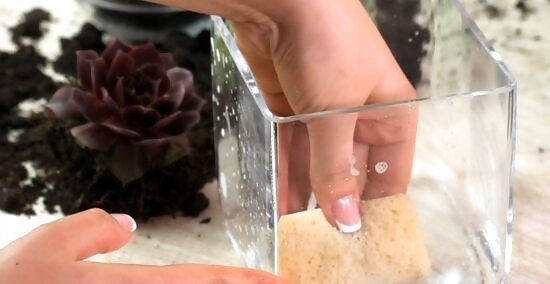
Clean the glass container with soap and water. If the container was previously used, wash it thoroughly with hot, soapy water and rinse it well to remove all soapy residue. Wait for the container to dry completely before you begin adding your growing media and plants. Even if the container was never used before, it’s still a good idea to wash it before planting in it. Let it air out for a few days so any water from the washing, as well as manufacturing residue, can evaporate.
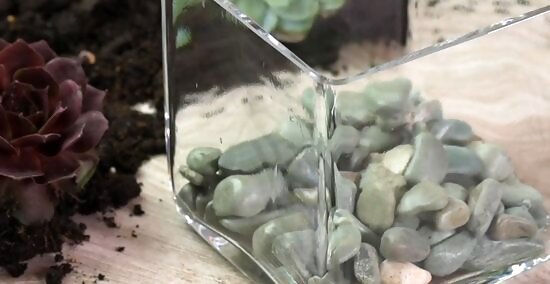
Add rocks to the bottom of the container for drainage. Pour some horticultural gravel or aquarium pebbles into the bottom of the container. While the amount you need to put in will vary depending on the size of your terrarium, a layer about 1 to 1.5 inches (2.5 to 3.8 cm) deep is usually sufficient. You can buy gravel or pebbles at gardening centers or pet supply stores. You could also use crushed pottery, rock chips, or even glass marbles for your drainage layer. This drainage layer is necessary to prevent the soil from becoming soggy in your terrarium, which can lead to problems with mold, bacteria, and root rot.
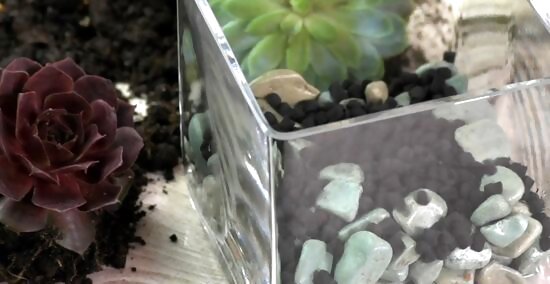
Pour in a layer of activated charcoal. Activated charcoal acts as a filter in your terrarium, removing toxic chemicals from the water and soil. Put a layer about ⁄2 inch (1.3 cm) deep on top of your drainage material. The charcoal is most effective if it sits on top of the drainage layer. However, if you’re working with a very small container, you can also mix the charcoal into the drainage material. You can purchase activated charcoal from a pet or garden supply store.
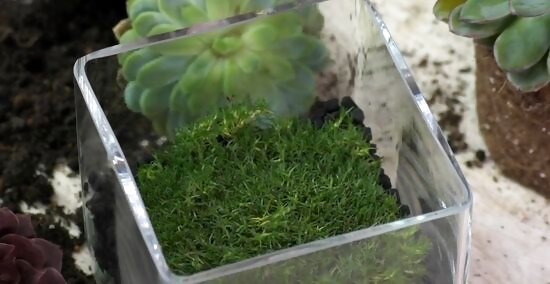
Put a layer of sphagnum moss on top of the charcoal. Take some dried sphagnum or sheet moss and soak it in water for a few seconds. Squeeze out the moss so it’s slightly damp, but not dripping wet. Place the moss on top of the layer of charcoal to prevent soil from filtering down into the drainage layer. Keep the layer of moss thin. You only need enough to completely cover the charcoal layer. You can purchase sheet moss or sphagnum moss at a pet store or home and garden supply center.
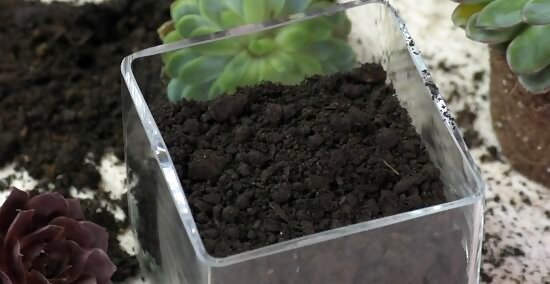
Dump in your growing medium. Cover the layer of moss with some potting soil that’s appropriate for the plants you’ll be growing (e.g., succulent mix if you’re building a desert terrarium, or a general potting soil for tropical plants). It’s helpful to dampen the soil slightly first to reduce dust. Make it moist, but not muddy. The amount of soil you’ll need will vary depending on the size of your terrarium, but you’ll probably need to add a layer at least 1 ⁄2 inches (3.8 cm) deep to accommodate the roots of your plants. Ideally, all the material you’ve added so far should take up about ¼ of the depth of the container. If your container has a narrow opening, use a large funnel to pour in the soil.
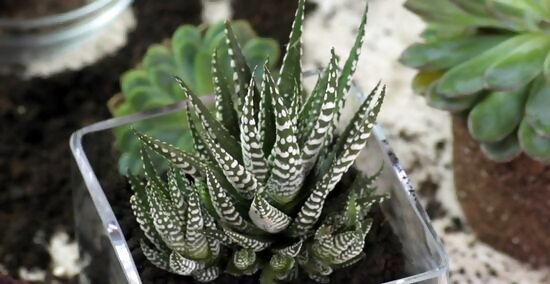
Insert your plants into holes in the soil. Use your finger or a tool (such as a chopstick) to make shallow holes in the soil. Remove a plant from its container and tease the roots gently apart to remove excess soil. Nestle it carefully into a hole and add more soil around it, patting it down gently. Repeat with the rest of the plants. Before adding any plants, trim off any dead foliage. It’s also a good idea to treat them with a gentle pesticide, such as neem oil or dilute dish soap, to get rid of any hidden bugs or other pests. Make sure to leave 1–2 inches (2.5–5.1 cm) between the plants if possible so that there’s plenty of room for air flow between them. Trim the leaves so that they don’t touch the edges of the terrarium or the other plants, if necessary.
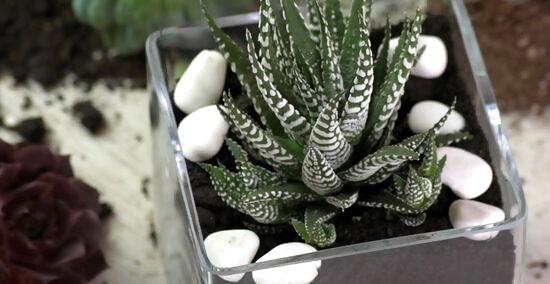
Place some decorations in the terrarium if you like. If you wish, you can add some small figurines, marbles, or other decorations to give your terrarium a fun or elegant look. You can also add moss or pebbles between the plants to make it look a little neater. Get imaginative with the decorations if you want. For example, you could add some pretty crystals to create a fairy garden look, or add some sand and seashells for a beach theme.
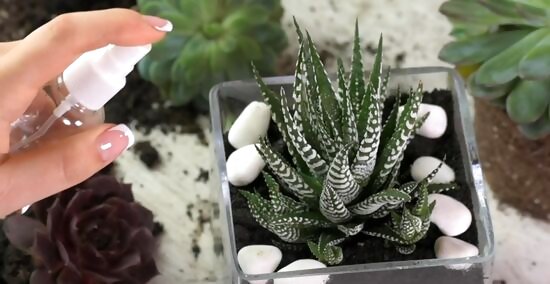
Mist the plants to water them. If you already moistened the growing medium, you won’t need to add a lot of water. Use a plant mister to spritz down the foliage and the top layer of soil. If you plan to cover your terrarium, wait one day and mist the plants again. Then, once the foliage is completely dry, add the cover.
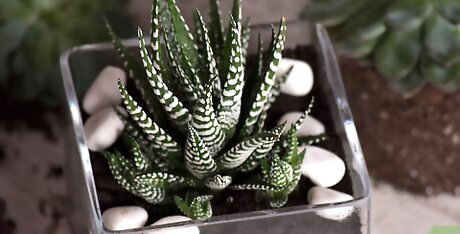
Keep the terrarium in a place where it will get enough light and warmth. Terrariums are ultra low-maintenance, but in order to remain so they must be placed in an ideal location. Research the needs of your plants and put the terrarium in a spot where they’ll get the kind of light and temperature conditions they require.Warning: Avoid putting a closed or tall-sided terrarium in direct sunlight, since the glass will trap heat and even magnify the sunlight. This can easily cause your plants to overheat or get singed. For example, if you’re growing succulents in a shallow dish, put your terrarium in a sunny window so they can get plenty of light throughout the day. Ferns will probably do better in an area where they get filtered light (such as near a window with gauzy curtains over it). Avoid keeping your terrarium in a spot where it will be exposed to temperature extremes or temperature fluctuations, such as near a heater, air conditioner, or drafty doorway. Put the terrarium in a stable location where it won’t get knocked over easily.
Maintaining Your Garden
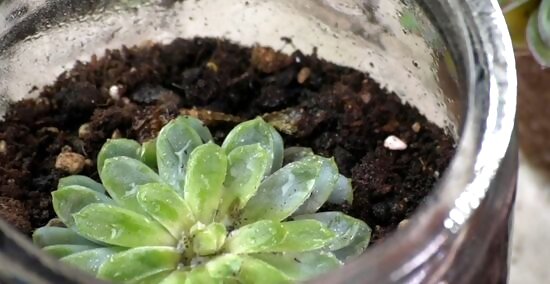
Water your plants whenever the soil gets dry. If your terrarium is open, you’ll need to give it frequent, light waterings. Use your finger to test the soil every few days. If it feels dry beneath the surface, mist your plants or add enough water to the soil to make it moist, but not wet. Take care not to over-water your plants. Standing water in a terrarium can quickly lead to rot. If your terrarium is completely closed, it may only need watering every 4-6 months.
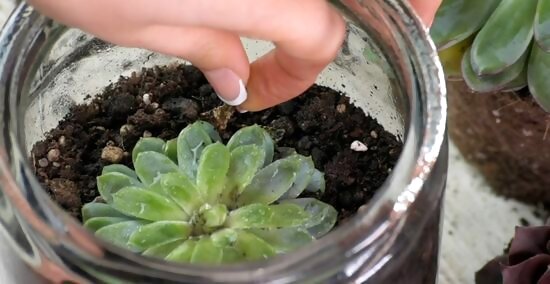
Remove any unhealthy foliage. If you see weeds, mold, or sick plants, remove the affected foliage or soil immediately. Also, remove wilting parts of the plant, such as old flowers or dead leaves. You can also prevent larger plants from outgrowing their space by regularly pruning them or pinching back the tips.
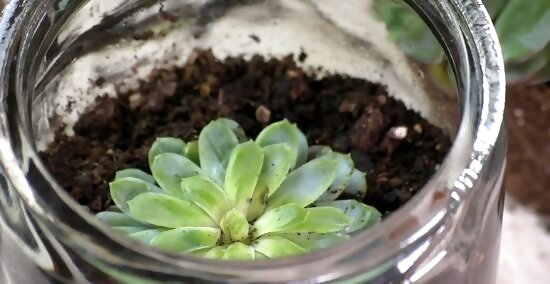
Air out enclosed terrariums after watering them. If your terrarium is airtight, air it out any time you water the plants. Wait until the foliage is completely dry before you put the cover back on. It’s also a good idea to air out your terrarium if you notice a lot of condensation on the walls or mold starting to grow in the soil.












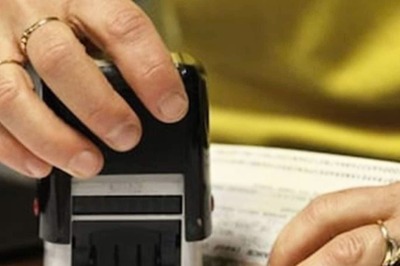







Comments
0 comment